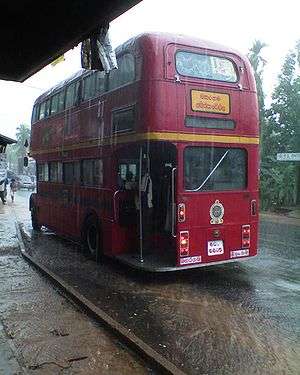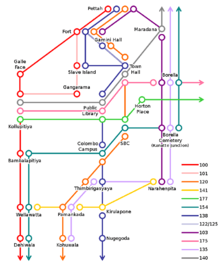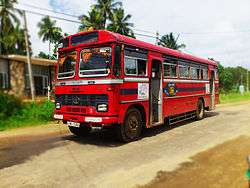Sri Lanka Transport Board
The Sri Lanka Transport Board (Sinhala: ශ්රී ලංකා ගමනාගමන මණ්ඩලය Shri Lanka Gamanāgamana Mandalaya)(formerly: Ceylon Transport Board, CTB) is a bus service provider in Sri Lanka.
 | |
| Founded | 1 January 1958, as Ceylon Transport Board |
|---|---|
| Headquarters | Narahenpita, Colombo, Sri Lanka |
| Service area | Sri Lanka |
| Hubs | Central Bus Station (CBS), Pettah, Colombo |
| Fleet | 6178 (2016)[1] |
Between 1958 and 1978, the Ceylon Transport Board (CTB) was the nationalised enterprise which handled all public bus transport in Sri Lanka. At its peak, it was the largest omnibus company in the world — with about 7,000 buses and over 50,000 employees. With privatization in 1979, it underwent a period of decline.
First broken up into several regional boards, then into several companies, it was finally reconstituted as the Sri Lanka Transport Board in 2005.
In 2016, the number of buses in the fleet was 7769, of which 6178 were in operation. In the same year, SLTB had a total of 32,640 employees.
History

The first motor omnibus in Sri Lanka was imported in 1907 and bus transport began in Sri Lanka as an owner-operated service. There was no regulation, so when more than one bus operated on a single route, there was a scramble for the load. By the mid-1930s, malpractices in pursuit of maximum profit began to compromise safety and comfort. The setting up of the limited liability omnibus companies by the British around 1940 was the first meaningful step in regularising public passenger transport in the country.
The Ratnam Survey in 1948, the Sansoni Survey in 1954 and the Jayaratna Perera Survey in 1956 studied the bus services in Sri Lanka and all recommended that the companies should be nationalised.
The history of Sri Lanka Transport Board goes back to 1 January 1958; at the time known as the Ceylon Transport Board (CTB). The inaugural trip of the CTB took the Prime Minister and the Transport and Works Minister Maithripala Senanayake on a maroon luxury Mercedes-Benz bus imported from Germany. The bus is still owned by the Nittambuwa Bus Depot.
At its peak, it was the largest omnibus company in the world — with about 7,000 buses and over 50,000 employees. With privatization in 1979, it underwent a period of decline. The creation of a single nationalised entity made possible long distance operations and running buses on a large number of rural routes.
First broken up into several regional boards, then into several companies, it was finally reconstituted as the Sri Lanka Transport Board in 2005. The move received bipartisan support in Parliament. It was hailed by the Joint Business Forum (J-Biz), which welcomed the revival of the CTB: this was one of the rare occasions on which the business community said a state bus service was better than privatised ventures.[2]
Services

SLTB serves both urban and rural routes. In many rural areas, it provides services in unprofitable areas that would be unattractive to private operators.[3]
Urban routes
Colombo has an extensive public transport system based on buses, some of which is operated by SLTB. The Central Bus Stand in Pettah functions as the primary hub for bus transport in Colombo.[4]
The road network in Colombo consists of radial links (or arterial routes), which link the city centre and district centres, and orbital links, which intersect the arterial routes; most bus routes run along the radial links without the benefit of dedicated bus lanes owing to the high volume of traffic at peak times.[5] A BRT system for Colombo has been proposed, but has yet to be implemented.[6][7]
Intercity routes
SLTB also serves many intercity routes. These routes connect many of the major population centres in the country.
As of January 2012, SLTB is the only bus operator on the Southern Expressway. It uses modern Lanka Ashok Leyland buses on the expressway to connect Galle with Maharagama. The buses operate every two hours.[8]
As of 2013, the SLTB has started operating on the Katunayake Expressway providing access for people from Negombo, Katunayake, Puttalam, etc. to maintain access within 20 minutes.
Fleet

Most of the fleet consists of buses from Lanka Ashok Leyland, Dennis, Volvo, Yutong, Tata, Mitsubishi and Isuzu. The SLTB is currently expanding its fleet, by ordering new buses from Volvo.[9][10] The buses ordered have modern facilities, including low-floor design and air-conditioning. In July 2011, trial runs began in Colombo to gauge passengers' response to the new buses.[11]
Livery
Most SLTB buses have a red livery and are easily recognisable.
Past liveries
The CTB originally painted its buses red and blue. The second-hand London Transport buses, which were the backbone of the fleet, just needed to be half-painted in blue, saving on costs. When aluminium bus bodies became the norm, large areas of the surface were left unpainted, with just red front and back and blue strips down the side, in order to save money.
Logo

The Logo was originally a blue oval with the words 'CTB' and the equivalents in Sinhala and Tamil painted on it in red. From 1970 this was replaced by an oval with a lion rampant or on field azure.
The present SLTB logo returns to the 1970s symbols, but with 'SLTB' instead of 'CTB' in Roman lettering, with 'Sri' added to the Sinhala script and no change in the Tamil script.
Transit Competitors
SLTB buses compete with private buses throughout the country, as well as with rail services by Sri Lanka Railways.
Integration issues
Sri Lanka Transport Board has not integrated its services with other modes of transport, such as rail. Unlike transport systems in some other countries, Sri Lanka does not have a streamline ticket system between road and rail transport. Buses do not provide dedicated feeder-bus services to the railways, resulting in commuter rail and buses acting as isolated systems in relation to each other, which creates a loss in efficiency.[12]
See also
References
- "Sri Lanka Transport Board - Basic Information". Sri Lanka Transport Board. Retrieved 6 November 2017.
- "Private buses and the CTB". LankaNewspapers.com. Retrieved 2 October 2005.
- "Sri Lanka Transport Board to import 2,000 single door buses for rural transportation". ColomboPage. 5 December 2011. Retrieved 6 December 2011.
- "Transport in Colombo". Lonely Planet. Lonely Planet Publications. Archived from the original on 3 March 2009. Retrieved 28 April 2009.
- Cader, Fathima Razik (23 January 2004). "One-way streets in Colombo". Daily News. The Associated Newspapers of Ceylon Ltd. Archived from the original on 9 November 2010. Retrieved 27 April 2009.
- Mushtaq, Munza (5 July 2006). "Sri Lanka to get a Bus Rapid Transit System courtesy Japan". Asian Tribune. Retrieved 14 December 2011.
- http://www.gobrt.org/BRTinAsia.pdf BRT Planned or Under Construction in Asia
- Perera, Chaminda (3 January 2012). "Toning Southern Expressway: Luxury bus service starts today". Ceylon Daily News. Archived from the original on 19 February 2013. Retrieved 4 January 2012.
- "Sri Lanka Transport Board to get 100 new buses from India". ColomboPage. Retrieved 11 August 2011.
- "SLTB to introduce luxury bus service soon". Daily Mirror. Retrieved 11 August 2011.
- "Luxury bus, a boon to office workers". Sunday Observer. Archived from the original on 30 July 2011. Retrieved 11 August 2011.
- "Archived copy" (PDF). Archived from the original (PDF) on 26 March 2010. Retrieved 12 November 2011.CS1 maint: archived copy as title (link) ADB Sector Paper. Sri Lanka Country Assistance Program Evaluation: Transport Sector. August 2007
Further reading
- Aryadasa Ratnasinghe, 'The development of bus transport in Sri Lanka', Daily News, 12 October 2004.
- Chandra Edirisuriya, 'To mark landmark foreign participation in public transport in Sri Lanka : Annals of omnibus transport', Daily News, 18 December 2002.
- Dinesh Gunawardena, ‘Anil Moonesinghe - a political and managerial visionary’, Daily News, 8 Dec 2005.
- Editorial, 'Resurrecting the CTB', Sunday Observer, 27 March 2005.
- Jayantha Sri Nissanka and Ranga Jayasuriya, 'Resurrection of the SLTB', Sunday Observer, 2 October 2005.
- 'Private buses and the CTB', LankaNewspapers.com, 2 October 2005.
- R.W. Faulks, 'Sri Lanka transport history involved frequent change', BUSES INTERNATIONAL, August 2001.
- Special Correspondent, 'Paving the way for resurrection of CTB', Sunday Observer, 3 April 2005.
- 'Sri Lanka Transport Board to raise the bus fleet', Colombo Page, 4 July 2007.
- 'Battling iron-eating rats in the CTB', The Island, 4 September 2008.